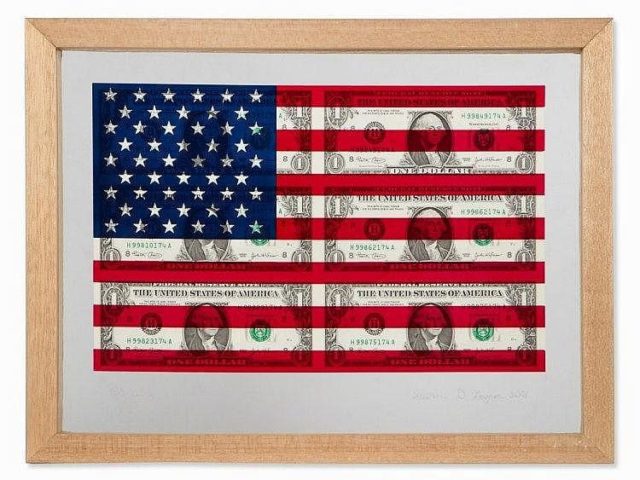Steven Gagnon (American)
The Dollar Spangled Banner, 2001
Serigraph collaged with one-dollar bills
12″ x 16″
Gift of James G. Pepper, Class of 1965
Steven Gagnon, born in 1973, grew up in Fort Pierce, Florida. Hopping from one weather-perfect locale to another, the artist studied at Pepperdine University in Malibu, CA, and returned to his hometown to pursue art under the mentorship of visual artist, Nataly Nijinsky. Through his career, Gagnon has exhibited across the United States, participating in group shows at the Naples Museum of Art, Palm Springs Desert Museum, Bladen Memorial Museum of Art, Museum of South Texas, and Mary Brogan Museum of Art and Science, among others. He has featured work in numerous major news publication across the country.
Gagnon’s work is distinctively and undyingly political. Working predominantly in serigraph, a labor-intensive screen-printing technique advanced and popularized in the United States by Andy Warhol, Gagnon has dedicated his life’s work to interrogating what it is be American through manifold representation of cultural symbols and iconography. Gagnon is a pop artist through and through – another quintessentially American aspect of his practice. By employing the techniques and political sensibilities of the movement’s foundational figures – Jasper Johns and Andy Warhol – Gagnon picks up the post-war movement and uses its language to advance the same set of the ideas in a contemporary era.
This work is simple, and it’s message is immediately apparent. In printing the stars and stripes over currency, the artist assigns a specific value to the American identity and points out its inextricable link to consumerism. Gagnon grounds the abstract in the necessarily concrete. Based in juxtaposition, the artist’s critique is direct and brilliantly colored, subverting American culture and the structures that define it. What better day to reconsider our country’s culture and structural underpinnings than the Fourth of July!
Something to consider: Gagnon’s work exists in a number of art collections, many of which belong to banks and private financial institutions. What does that particular representation mean for the Gagnon’s ideological fidelity and how can we reckon with the paradox of selling anti-consumerist art?
Sebi Sola-Sole ’21

